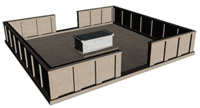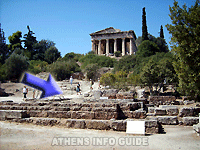
Ancient Agora
North-west side
The Altar of the Twelve Gods
 This
rectangular altar, enclosed in a peribolos wall (a wall that
enclosed sacred areas), is near the north end of the Agora. This
rectangular altar, enclosed in a peribolos wall (a wall that
enclosed sacred areas), is near the north end of the Agora.
It was identified by an inscribed
marble statue base found on the west side of the peribolos wall.
The original altar was built in 522/21 BC by Peisistratos and
it was rebuilt in 425 BC to repair damage suffered in the Persian
invasion of 480/79 BC. The altar was used as the central point
for measuring road distances. From the 5th century BC, the altar
became associated with the Goddess of Pity, probably because
the enclosed area served as a place of asylum. A round marble
altar of the 4th century BC may also have been in the sanctuary.
 A
low poros wall (peribolos) enclosed the altar. The wall consisted
of poros slabs and posts. There were two entrances located in
the middle of the east and west sides. Trees or shrubs were planted
within the enclosure, around the altar. There were also a few
stone water basins. A
low poros wall (peribolos) enclosed the altar. The wall consisted
of poros slabs and posts. There were two entrances located in
the middle of the east and west sides. Trees or shrubs were planted
within the enclosure, around the altar. There were also a few
stone water basins.
The north and south sides of
the original enclosure measured 9.35 m (30.6 ft) and the east
and west sides 9.86 m (32.35 ft). When the enclosure was restored
around 425 BC, its north and south sides were shortened to 9.05
m (29.69 ft). Only one of the corners is visible today. The rest
of the structure has been excavated but has since been covered
by railway tracks. As the Altar of the Twelve Gods was almost
in the middle of the Agora, it was considered to be the city
centre. 
Temple of Ares
The foundations of the Temple
and altar of Ares are situated in the middle of the Agora’s
open square, north of the Odeion of Agrippa. The marble Doric
temple was built ca. 430 BC. It was modeled on the architectural
type of the Temple of Hephaestus (Hephaisteion).
The temple was originally founded
elsewhere, possibly at Acharnai on the slopes of Mount Parnis,
but was dismantled and transferred in about 15 BC to the Agora
where it was set up on new foundations.
Together with the south-east
and south-west temples, it belongs to the distinctive building
program during the reign of Augustus when many fine examples
of Classical architecture were transferred to the Agora, mostly
for the purpose of serving imperial cults. 
 Temple
of Apollo Patroos Temple
of Apollo Patroos
The temple, dedicated to Apollo,
was erected between 340 and 320 BC. It was a small temple built
according to the Ionic order and its name Patroos, which means
Father, refers to the god Apollo, who was worshipped as the founder
of the Ionian nation. The cult statue of the god stood inside
the cella and it was sculptured by Euphranor.
Under this temple are the remains
of a smaller, apsidal Temple of Apollo (6th century BC). The
earlier temple was probably destroyed by the Persians in 480/79
BC.
The temple contained a pronaos
(the inner area of the portico), a cella (the inner chamber of
a temple and an adyton (inner sanctuary) to the north. According
to Pausanias there were three statues of Apollo inside the temple.
The cult statue of the god was a work by the sculptor Euphranor.
It is identified with the statue of Apollo Kitharodos found in
the area and exhibited in the Ancient Agora Museum. The statue
of Apollo Alexikakos was made by the sculptor Kalamis and another
one by Leochares.
In front of the adyton of the
temple are the remains of a small temple (5,20 m by 3,65 m – 17
ft by 11.97 ft) which has been dated to the mid-4th century BC
and identified as the Temple of Zeus Phratrios and Athena Pharatria,
both protectors of the Athenian phratries (brotherhoods). 
The Arsenal
The arsenal is situated at the
feet of the Agoraios Kolonos hill, to the northeast of the Hephaisteion.
The foundations of the large rectangular building (17,6 m by
44,4 m – 57.74 ft by 145.66 ft) have been preserved and
dated to the beginning of the 3rd century BC.
Its interior was divided in
three naves with two rows of eight pillars that supported the
walls and the wooden roof of the building. It was used as a space
for the safekeeping of weapons and other military material. It
is also possible that the oil destined for the winners of the
Panathinaic Games was kept here.
 The
statue of Hadrian The
statue of Hadrian
A slightly larger than life-size
statue of the Roman Emperor Hadrian (117-138 AD) sited in the
eastern portion of the Ancient Agora faces the government buildings
to the west. Hadrian was a great lover of Greek culture and rebuilt
and added many structures to Athens.
This statue was originally placed
in the Stoa of Zeus. The chest piece that he wears is called
a cuirass. Note the children Romulus and Remus that are sucking
the wolf. Romulus and Remus are legendary twins who, after being
abandoned, were suckled by a wolf and in adulthood founded the
city of Rome. Thus the wolf and twins evokes the memory of (the
founding of) Rome.
The goddess of Athens - Athena
- stands upon the wolf, indicating how Hadrian viewed Greek culture
as being supported by Rome.

|



 A
low poros wall (peribolos) enclosed the altar. The wall consisted
of poros slabs and posts. There were two entrances located in
the middle of the east and west sides. Trees or shrubs were planted
within the enclosure, around the altar. There were also a few
stone water basins.
A
low poros wall (peribolos) enclosed the altar. The wall consisted
of poros slabs and posts. There were two entrances located in
the middle of the east and west sides. Trees or shrubs were planted
within the enclosure, around the altar. There were also a few
stone water basins.
 Temple
of Apollo Patroos
Temple
of Apollo Patroos The
statue of Hadrian
The
statue of Hadrian










